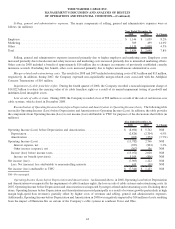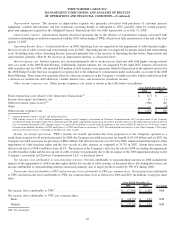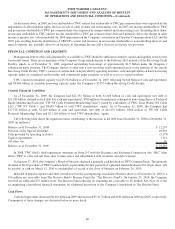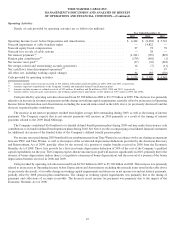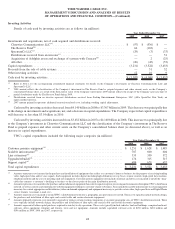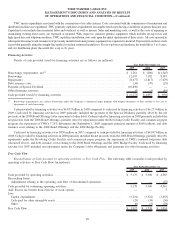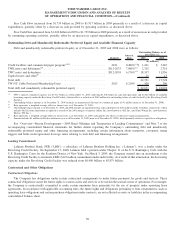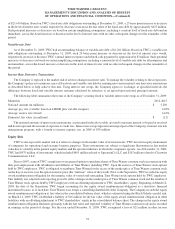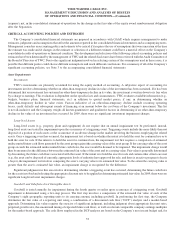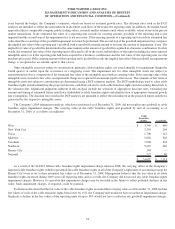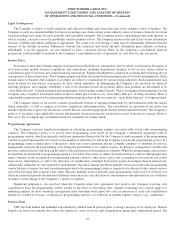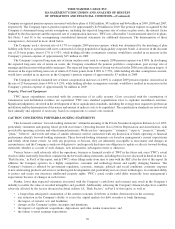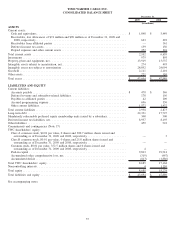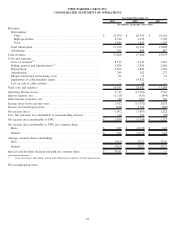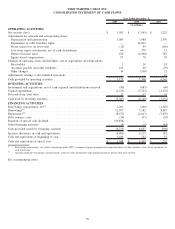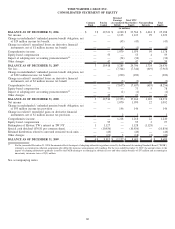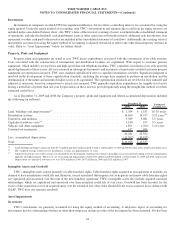Time Warner Cable 2009 Annual Report Download - page 66
Download and view the complete annual report
Please find page 66 of the 2009 Time Warner Cable annual report below. You can navigate through the pages in the report by either clicking on the pages listed below, or by using the keyword search tool below to find specific information within the annual report.
years beyond the budget, the Company’s estimates, which are based on assumed growth rates. The discount rates used in the DCF
analyses are intended to reflect the risks inherent in the future cash flows of the respective reporting units. In addition, the market-based
approach utilizes comparable company public trading values, research analyst estimates and, where available, values observed in private
market transactions. If the estimated fair value of a reporting unit exceeds its carrying amount, goodwill of the reporting unit is not
impaired and the second step of the impairment test is not necessary. If the carrying amount of a reporting unit exceeds its estimated fair
value, then the second step of the goodwill impairment test must be performed. The second step of the goodwill impairment test compares
the implied fair value of the reporting unit’s goodwill with its goodwill carrying amount to measure the amount of impairment, if any. The
implied fair value of goodwill is determined in the same manner as the amount of goodwill recognized in a business combination. In other
words, the estimated fair value of the reporting unit is allocated to all of the assets and liabilities of that unit (including any unrecognized
intangible assets) as if the reporting unit had been acquired in a business combination and the fair value of the reporting unit was the
purchase price paid. If the carrying amount of the reporting unit’s goodwill exceeds the implied fair value of that goodwill, an impairment
charge is recognized in an amount equal to that excess.
Other intangible assets not subject to amortization, primarily cable franchise rights, are tested annually for impairment during the
fourth quarter or earlier upon the occurrence of a triggering event. The impairment test for other intangible assets not subject to
amortization involves a comparison of the estimated fair value of the intangible asset with its carrying value. If the carrying value of the
intangible asset exceeds its fair value, an impairment charge is recognized in an amount equal to that excess. The estimates of fair value of
intangible assets not subject to amortization are determined using a DCF valuation analysis. The DCF methodology used to value cable
franchise rights entails identifying the projected discrete cash flows related to such cable franchise rights and discounting them back to
the valuation date. Significant judgments inherent in this analysis include the selection of appropriate discount rates, estimating the
amount and timing of estimated future cash flows attributable to cable franchise rights and identification of appropriate terminal growth
rate assumptions. The discount rates used in the DCF analyses are intended to reflect the risk inherent in the projected future cash flows
generated by the respective intangible assets.
The Company’s 2009 impairment analysis, which was performed as of December 31, 2009, did not result in any goodwill or cable
franchise rights impairment charges. The carrying value of the cable franchise rights and goodwill by unit of accounting as of
December 31, 2009, is as follows (in millions):
Cable
Franchise
Rights Goodwill
West.......................................................................... $ 3,350 $ 489
New York City .................................................................. 3,345 204
Texas ......................................................................... 1,700 143
Midwest ....................................................................... 5,028 505
Carolinas ....................................................................... 3,908 224
Northeast....................................................................... 5,645 466
Kansas City ..................................................................... 394 —
National ....................................................................... 722 80
$ 24,092 $ 2,111
As a result of the $14.822 billion cable franchise rights impairment charge taken in 2008, the carrying values of the Company’s
impaired cable franchise rights (which represented the cable franchise rights in all of the Company’s eight units of accounting except for
Kansas City) were re-set to their estimated fair values as of December 31, 2008. Management believes that the fair value of its cable
franchise rights increased during 2009 across all reporting units and as a result, the Company did not record any cable franchise rights
impairment charges. However, it is possible that impairment charges may be recorded in the future to reflect potential declines in fair
value. Such impairment charges, if required, could be material.
To illustrate the extent that the fair value of the cable franchise rights exceeded their carrying value as of December 31, 2009, had the
fair values of each of the cable franchise rights been lower by 15%, the Company still would not have recorded an impairment charge.
Similarly, a decline in the fair values of the reporting units by up to 30% would not have resulted in any goodwill impairment charges.
54
TIME WARNER CABLE INC.
MANAGEMENT’S DISCUSSION AND ANALYSIS OF RESULTS
OF OPERATIONS AND FINANCIAL CONDITION—(Continued)


